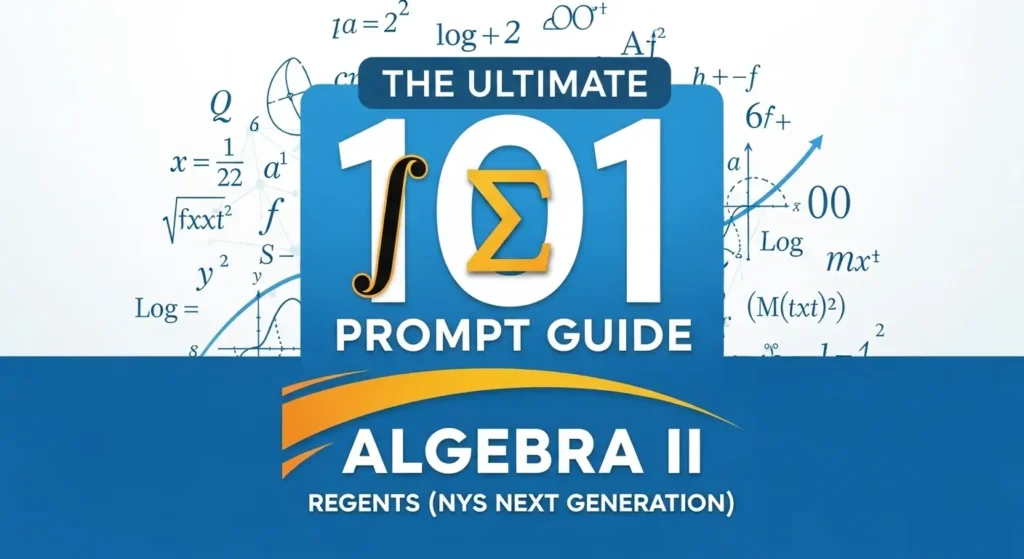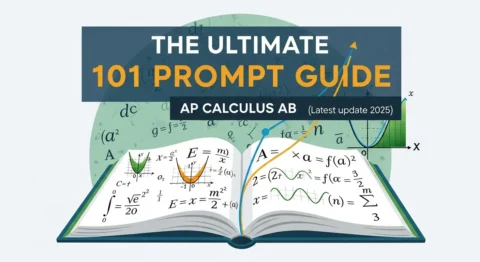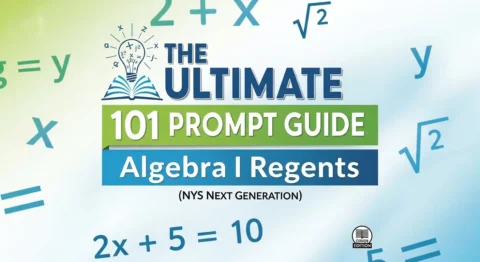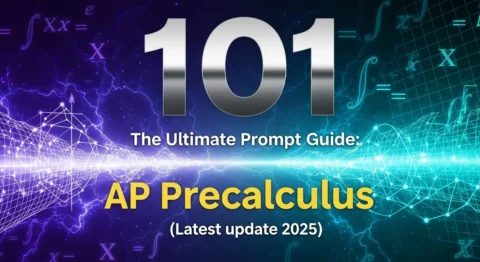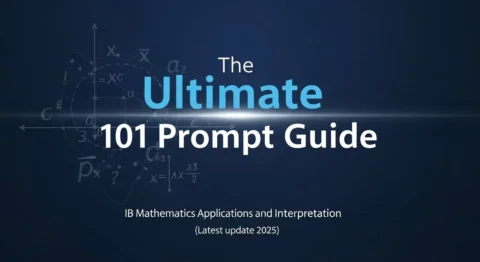Algebra II Regents (Next Generation) — 101 Prompt Guide (2025–26 Edition)
Aligned to the New York State Next Generation Mathematics Learning Standards and the new Algebra II Regents blueprint (first administration: June 2026). Use these copy‑and‑paste prompts with any modern AI assistant (ChatGPT, Claude, Gemini) to accelerate lesson design and study. Facts herein (domains, blueprint %s, test structure, timing, tools, PLDs, and the official Reference Sheet) are drawn from NYSED’s Educator Guide, standards documents, and reference materials.
How to use this guide
For educators: Prompts are grouped by Planning → Delivery → Assessment → Enrichment and reference high‑school Algebra II domains (N‑RN/N‑CN; A‑SSE/A‑APR/A‑CED/A‑REI; F‑IF/F‑BF/F‑LE/F‑TF; S‑ID/S‑IC/S‑CP). Ask for tables, rubrics, keys, or print‑ready pages where needed.
For students: Prompts are grouped by Understanding → Practicing → Revising → Preparing for assessment. Request worked steps, hints, or scaffolds.
Outputs: Most prompts include a preferred format (e.g., Markdown table, CSV, step‑by‑step solutions) to get high‑quality, ready‑to‑use results.
Curriculum & exam snapshot (for quick context)
Conceptual categories & % of test (by credits):
Number & Quantity (N‑RN, N‑CN) 4–8% • Algebra (A‑SSE, A‑APR, A‑CED, A‑REI) 30–39% • Functions (F‑IF, F‑BF, F‑LE, F‑TF) 38–45% • Statistics & Probability (S‑ID, S‑IC, S‑CP) 14–22%.Exam design & timing: 36 questions / 82 raw credits split as Part I: 24 MC (2 cr each, 48); Part II: 8 CR (2 each, 16); Part III: 3 CR (4 each, 12); Part IV: 1 CR (6, 6). 3 hours. Graphing calculator + straightedge required; no calculators with symbolic manipulation or communication features. A detachable Algebra II Reference Sheet (NGLS) is provided with formulas/identities.
Standards & practices: Assessment targets the Next Generation Mathematics Learning Standards and integrates the Standards for Mathematical Practice (MP1–MP8).
Transition note: 2011 Common Core Algebra II remains in effect through January 2026; Next Generation Algebra II begins June 2026. Use Next Gen materials for 2026+ runs.
Reference Sheet: Official Algebra II (Next Gen) Reference Sheet includes quadratic formula, trig identities, cubic factorizations, probability rules, etc. Use it in instruction all year.
SECTION 1 — Educator Prompts (50)
Grouped by Planning (P), Delivery (D), Assessment (A), and Enrichment (E). Replace [brackets] with your specifics.
A. Planning (13)
P1. Year map by blueprint
Role: You are my Algebra II curriculum designer. Task: Build a year‑long pacing map aligned to the Algebra II Regents blueprint with percent‑by‑credit weights and domain codes (N‑RN/N‑CN; A‑SSE/A‑APR/A‑CED/A‑REI; F‑IF/F‑BF/F‑LE/F‑TF; S‑ID/S‑IC/S‑CP). Output: Markdown table (Unit | Standards | Weeks | Priority (H/M/L) | Regents Weight | Major Assessments). Include milestones for Jan mock and May full mock.
P2. Unit plan—Polynomial & Rational Expressions (A‑APR, A‑SSE)
Design a 2‑week unit (12 lessons) covering operations with polynomials, long/synthetic division, rational expressions, and structure in expressions. Include: daily objectives, success criteria, worked examples, common misconceptions, and exit tickets linked to A‑APR & A‑SSE clusters. Output: table + printable exit tickets.
P3. Radical & Rational Equations (A‑REI)
Create a mini‑unit (5 lessons) on solving radical and rational equations, identifying extraneous solutions. Provide three real‑world modeling problems (A‑CED + A‑REI) and teacher keys.
P4. Complex Numbers (N‑CN)
Unpack N‑CN for Algebra II: operations, conjugates, inverses, solving quadratics with complex roots, and interpreting solutions. Output: concept map + short teacher narrative (≤200 words) + 10 quick checks.
P5. Exponential & Logarithmic Functions (F‑BF.5a, F‑LE)
Create a 7‑lesson sequence connecting exponent rules → inverses → logarithms → solving exponential/log equations → modeling growth/decay (parameter interpretations). Include calculator and no‑calculator tasks.
P6. Trigonometry via Unit Circle (F‑TF.A/C)
Plan a 6‑lesson arc on radian measure, unit circle values, trig identities (incl. sin²θ+cos²θ=1, reciprocal & quotient identities), and verifying identities (F‑TF.1,2,4,8). Include a “when to use which identity” flowchart.
P7. Periodic Modeling (F‑TF.B)
Draft a project‑based lesson set where students model periodic data (temperature, tides) with sine/cosine; fit parameters (amplitude, midline, period, phase). Include rubric aligned to F‑TF.5.
P8. Inverses & Composition (F‑BF)
Create lesson notes and tasks on function composition and inverses (algebraic and graphical). Include one context for each (e.g., °C↔°F), and domain/range restrictions.
P9. Sequences & Series (F‑BF.6,7)
Build a mini‑unit on arithmetic/geometric sequences and finite sums using sigma notation; include derivation activities and applications (savings plans). Provide mixed assessment items.
P10. Probability & Independence (S‑CP)
Plan a 4‑lesson sequence on conditional probability, independence tests, addition/multiplication rules, and Venn/tree diagrams. Include common fallacies tasks.
P11. Inference Overview (S‑IC)
Create a designer’s brief aligning sampling, experiments, randomization, and inference statements (S‑IC.2,3,4,6a,6b). Include do‑now probes and a lab outline (randomization demo).
P12. Reference Sheet fluency days
Design two lessons that teach students to choose the correct formula/identity from the Algebra II Reference Sheet; include station tasks and quick‑decision drills. Output: station cards + key.
P13. UDL/EL scaffolds per unit
For each unit, list 3 UDL adaptations (representation/action/engagement) and ELL scaffolds (sentence frames for explanations and justifications), with examples tied to A‑REI (justify steps) and MP6 (precision).
B. Delivery (14)
D1. Launch routine—“Structure Spotting” (A‑SSE.2)
Create a 15‑minute warm‑up where students rewrite expressions by seeing structure (e.g., factoring by grouping, recognizing squares). Output: card sorts + debrief script.
D2. Think‑aloud—From exponents to logs (F‑BF.5a)
Write a teacher script showing how inverse relationships lead from a^x to log_a(x), including domain considerations and typical errors.
D3. Guided practice—Polynomial division (A‑APR)
Generate 12 problems (long & synthetic). Include “check your result” via multiplication and a note on when each method is preferable.
D4. Error analysis set—Rational expressions
Provide 10 incorrect student solutions (simplifying, complex fractions). Students must Find it → Fix it → Generalize. Include model responses.
D5. Multi‑representation routine—Quadratics & exponentials
Convert among table ↔ graph ↔ formula ↔ context (F‑IF/F‑LE). Provide 8 quick tasks plus sentence frames.
D6. Modeling mini‑lab—Piecewise functions
Create two real contexts (tiered pricing, speed zones). Students write piecewise definitions, sketch, and interpret intervals.
D7. Radian measure & arc length (F‑TF.1/2)
Produce a mini‑lesson with quick checks that connect degrees↔radians and length = rθ; include “units sanity check.”
D8. Identities workshop (F‑TF.4,8)
Develop 12 identity‑verification tasks with increasing complexity and a “when to attempt” strategy list.
D9. Systems with nonlinears (A‑REI)
Provide 6 tasks where a system mixes linear/quadratic or exponential/log; require both graph and algebraic solutions with a “method choice” justification.
D10. Residual reasoning (S‑ID.6a)
Give a small dataset; have students fit a line, compute two residuals, and interpret meaning in context (accuracy and direction).
D11. Normal distributions (S‑ID.4a,4b)
Create a mini‑lesson on mean/SD/empirical rule and z‑scores; include calculator steps and “draw & shade” sketches.
D12. Randomization demo (S‑IC.3,4)
Write a class activity to simulate random assignment and sampling; students must articulate valid inference claims.
D13. Talk moves for MP1–MP3
Provide teacher talk‑moves and student stems to support perseverance, reasoning, and argumentation in Algebra II contexts.
D14. Calculator strategy sheet
Summarize when to use table/graph/intersect, window settings, and domain restrictions—tie to F‑IF and F‑TF tasks.
C. Assessment (12)
A1. Full mock generator (Next Gen format)
Create a complete Algebra II mock matching the official design: Part I (24×MC, 2 cr), Part II (8×CR, 2 cr), Part III (3×CR, 4 cr), Part IV (1×CR, 6 cr). Provide answer key, rubrics, and a raw‑to‑scale score placeholder (note: conversions are exam‑specific).
A2. Domain‑balanced item bank
Build a spreadsheet of 120 items tagged by domain, cluster, DOK, calculator‑active/neutral; include MC distractor rationales and CR scoring notes.
A3. Constructed‑response rubrics (2/4/6 credits)
Draft analytic rubrics focusing on reasoning, precision (units, notation), and completeness; include model responses at varying quality. Base criteria on NYSED scoring guidance conventions.
A4. Quick checks (one per cluster)
Generate 20 one‑question exit tickets, each mapped to a distinct Algebra II cluster; provide keys.
A5. Blueprint coverage audit
Given my past quizzes, output a gap report vs. blueprint % ranges (N&Q 4–8, Algebra 30–39, Functions 38–45, S&P 14–22). Recommend rebalancing.
A6. Calculator‑neutral vs. calculator‑active pairs
Create 15 paired problems on the same concept, one solvable without a calculator, one requiring graph/trace/intersect.
A7. Reference Sheet mastery quiz
Author a 14‑item quiz that forces formula selection from the Algebra II Reference Sheet; include immediate feedback notes.
A8. Performance Level Descriptions (PLD) checker
For each unit, write 2 tasks at PLD Levels 3, 4, and 5 with teacher notes describing what a Level‑move looks like (e.g., from correct computation → justified generalization).
A9. Part II/III/IV sampler by domain
Produce: 8 two‑credit CR (Algebra heavy), 6 four‑credit CR (Functions/Trig), 2 six‑credit CR (Modeling/Inferences). Include rubrics.
A10. Misconception report
From a class dataset (upload later), output a table of most frequent errors (e.g., log properties, trig quadrant errors, extraneous roots) with targeted re‑teaches.
A11. Quarter benchmarks (Q1–Q3)
Create three cumulative benchmarks, each with blueprint‑balanced items and domain tags.
A12. Oral checks (MP3 emphasis)
Draft 10 brief oral‑assessment prompts where students must justify an algebraic step (A‑REI) or a parameter interpretation (F‑LE/F‑TF).
D. Enrichment (11)
E1. Math circle—Structure (A‑SSE.2)
Design a 50‑minute circle on spotting structure to quickly factor, complete the square, and linearize logs.
E2. Real‑data modeling studio (F‑LE, S‑ID, S‑IC)
Students collect/curate a dataset, choose linear/exponential/log models, justify choice, and present inference claims.
E3. Trig in the wild (F‑TF.5)
Build an outdoor lab measuring amplitude/period from shadows or pendulum data. Include safety and measurement notes.
E4. Financial math mini‑project
Savings with geometric series (finite sums), compounding, and effective rates; require a written argument connecting formulas to context.
E5. Complex plane art (N‑CN)
Create a project where students generate symmetrical designs in the complex plane; connect operations to transformations.
E6. Coding connections
Map function composition/inverses to function calls in code; have students “debug” domain/range errors.
E7. Debate—best solving path
Give three non‑linear equations; teams argue for factoring vs. logs vs. numerical approaches given constraints.
E8. Careers mini‑profiles
Eight careers (data science, acoustics, finance) with two Algebra II application problems each.
E9. Student‑written Regents items
Provide a protocol/checklist for writing valid MC and CR items with standards tags and distractor logic.
E10. Visual proofs (where appropriate)
Develop visual/verbal proofs for trig identities and logarithm laws; include teacher tips for timing and rigor.
E11. “Reference Sheet boss level” game
Gamify quick‑choice formula selection under time pressure; add badges for accuracy and explanation quality.
SECTION 2 — Student Prompts (50)
Grouped by Understanding (U), Practicing (P), Revising (R), Preparing (Pr).
A. Understanding (13)
U1. Read the expression like a pro (A‑SSE.1–2)
Role: You’re my Algebra II tutor. Task: Explain how to “see structure” in expressions to factor or rewrite efficiently. Output: 150‑word explanation + 3 annotated examples.
U2. Polynomials overview (A‑APR)
Give me a concise guide to adding/multiplying/dividing polynomials and how that leads to rational expressions. Include 2 “check your result” tips.
U3. Radical & rational equations (A‑REI)
Explain how extraneous solutions arise and how to check for them. Show one worked example of each type.
U4. Complex numbers (N‑CN)
Teach me operations with complex numbers and how they appear when solving quadratics. Include one geometric interpretation in the complex plane.
U5. Logs from exponents (F‑BF.5a)
Show how logs are inverses of exponentials and why domains matter. Include a mini table matching forms (a^x=y, log_a(y)=x).
U6. Exponential vs. power vs. linear (F‑LE)
Give me a quick rule‑of‑thumb to decide which model fits a scenario, then an example of each with parameter meanings.
U7. Composition & inverses (F‑BF)
Explain function composition and inverse functions with one algebraic and one graphical example; discuss domain restrictions.
U8. Interpreting functions (F‑IF)
Given a graph, show how to find intercepts, zeros, intervals of increase/decrease, and end behavior.
U9. Trig basics via unit circle (F‑TF.1–2)
Explain radians, the unit circle, and how to read sin, cos, tan from coordinates. Include quadrant sign rules.
U10. Trig identities (F‑TF.4,8)
Give a short guide to verifying identities, starting with sin²θ+cos²θ=1 and reciprocal/quotient identities. Provide one full worked verification.
U11. Periodic modeling (F‑TF.5)
Explain amplitude, midline, period, phase shift, and how they relate to data. Include one model of temperature over a day.
U12. Probability & independence (S‑CP)
Teach me conditional probability, independence checks, and addition/multiplication rules with a Venn diagram example.
U13. Inference basics (S‑IC)
Contrast surveys, experiments, and observational studies; explain randomization and what claims are valid from each.
B. Practicing (13)
P1. 10‑minute slope/intercept review (F‑IF)
Make 8 quick problems: find slope from points, write line, interpret intercept. Provide answers.
P2. Division workout (A‑APR)
Give 10 problems mixing polynomial long and synthetic division; include one application.
P3. Rational expressions drill
Simplify, multiply/divide, add/subtract complex fractions (12 items). Flag where domain restrictions change.
P4. Solve‑it mix (A‑REI)
Create 9 equations: 3 radical, 3 rational, 3 exponential/log. Identify and discard extraneous solutions.
P5. Logs practice set (F‑BF.5a)
Nine problems using log rules (product/quotient/power) and solving for x; ask for checks.
P6. Composition & inverse reps (F‑BF)
Five problems to find (f∘g)(x) and f⁻¹(x) where possible; include domain notes.
P7. Quadratic & exponential comparisons (F‑LE)
From tables/graphs, decide which model fits; justify in a sentence. 8 items.
P8. Trig values quick drill (F‑TF.1–2)
List standard angles in radians; compute sin/cos/tan; identify quadrants. 12 items.
P9. Identity verification set (F‑TF.4,8)
Verify or refute 6 identities with a warning about domain restrictions.
P10. Modeling with sin/cos (F‑TF.5)
Fit a sinusoid to a mini dataset (5 points). State A, B, C, D parameters and interpret them.
P11. Probability paths (S‑CP)
Build trees/Venns for 6 scenarios; compute P(A), P(B), P(A∩B), P(A|B); determine independence.
P12. Normal distribution (S‑ID.4a,b)
Compute z‑scores and shaded areas for 6 cases; sketch each and explain the area verbally.
P13. Residuals in context (S‑ID.6a)
Given a small dataset, fit a line, compute two residuals, and interpret what they mean.
C. Revising (12)
R1. Error log coach
Upload or describe 10 mistakes; cluster them (algebraic manipulation, domain, units, calculator). Give a fix strategy for each cluster.
R2. One‑pagers (5 topics)
Make five concise one‑pagers for my hardest topics (you pick if I don’t): key ideas, formulas, worked example, self‑check.
R3. Formula choice flowchart
Create a decision tree for factoring vs. quadratic formula vs. logs vs. numerical methods with “stop if…” checkpoints.
R4. Complex numbers refresher
Generate 20 flashcards (front: prompt; back: worked answer) on N‑CN arithmetic and properties.
R5. Logs mini‑diagnostic
10 items escalating from inverse idea → rule use → solving; tag misses and recommend specific practice.
R6. Identity verification checklist
Give me a 10‑step checklist for verifying trig identities, with 4 practice items and solutions.
R7. Probability confusers
Create 8 “looks similar” tasks to distinguish P(A∩B), P(A∪B), and P(A|B); include short reasons.
R8. Inference claim tuner
I’ll paste a lab summary; output a corrected, valid inference statement with a brief why.
R9. Reference Sheet sprint
Give me 14 rapid‑fire prompts where I must select the correct formula/identity from the Algebra II Reference Sheet. Provide immediate feedback.
R10. Calculator pitfalls
List common graphing pitfalls (window, mode, radian/degree) and a 5‑item self‑check.
R11. Mixed representations
Provide 8 tasks moving among equation ↔ table ↔ graph ↔ words for one concept each (logs, trig, sequences).
R12. Vocabulary tune‑up
Make 40 flashcards on Regents‑style verbs (“determine,” “justify,” “state,” “model”) with what a complete answer must include.
D. Preparing for assessment (12)
Pr1. Personal study plan (blueprint‑aware)
Build a 3‑week study plan using the official blueprint weights (N&Q 4–8, Algebra 30–39, Functions 38–45, S&P 14–22). Output: calendar grid with daily goals.
Pr2. Part I sprint (24 MC)
Generate 24 new Part I multiple‑choice questions across all domains, with keys and 1‑line rationales.
Pr3. Parts II–IV sampler
Create 8×2‑credit, 3×4‑credit, and 1×6‑credit constructed‑response items on my weak areas; include full solutions.
Pr4. Timeboxing script
Give me an exam‑day pacing plan and a checklist (materials, calculator, Reference Sheet familiarity, show‑work habits).
Pr5. Self‑scoring rubric
Provide a concise rubric to self‑score my constructed responses (2/4/6 credits) with “how to earn the next credit” notes, consistent with Regents rating practices.
Pr6. Last‑mile misconceptions
List 20 common late‑stage errors (log rules, extraneous roots, quadrant signs) and one‑line fixes.
Pr7. Calculator strategy drills
Create 12 tasks that must use graph/table/trace/intersect effectively (with a small “paper‑first” variant).
Pr8. Mixed mock (fresh items)
Build a full mock exam (all parts) from unseen items; deliver raw score only (conversion charts vary by exam).
Pr9. Reflection form
After my mock, output a reflection template capturing time use, domain confidence, and top 3 action items.
Pr10. “Explain your steps” set (A‑REI/MP3)
Give 5 problems where grading focuses on justifying each algebraic step and precision of notation.
Pr11. Night‑before light plan
Create a 60‑minute plan: 20 min Part I mixed, 20 min features of functions & logs, 10 min trig identity check, 10 min Reference Sheet review.
Pr12. Day‑of warm‑up
Provide 10 short, confidence‑building problems spanning all domains, with instant answers on a second page.
SECTION 3 — Bonus Universal Prompt (1)
X1. Interdisciplinary Data‑to‑Model Studio (creative)
Role: You are a cross‑disciplinary coach (math + science + social science). Task: Design a 5‑day mini‑project where students collect/curate real data, choose and justify models (linear/exponential/log or sinusoidal), analyze residuals, make an inference claim with appropriate caveats, and present a 1‑page executive summary plus a 3‑minute oral defense. Standards: A‑CED, F‑LE, F‑TF, S‑ID, S‑IC; practices MP1–MP6. Output: Day‑by‑day plan, materials list, rubric aligned to PLD Levels 3→4→5, and checkpoints that require Reference Sheet use.
Why these prompts are aligned & current
Blueprint & domain weights, exam parts, timing, calculator/straightedge, question types: NYSED Educator Guide to Algebra II (Next Gen); Examination Design table; Testing Session and Time; Tools; CR credit levels.
Conceptual categories & domain list (N‑RN/N‑CN; A‑SSE/A‑APR/A‑CED/A‑REI; F‑IF/F‑BF/F‑LE/F‑TF; S‑ID/S‑IC/S‑CP) with % ranges: Blueprint page.
Reference Sheet (Next Gen Algebra II) availability and contents: official NYSED PDF.
Standards for Mathematical Practice & Next Generation Learning Standards basis: Educator Guide front‑matter.
Transition timeline (Common Core → Next Gen) and first Algebra II Next Gen administration: NYSED Mathematics page (last CC Algebra II Jan 2026; Next Gen Algebra II begins June 2026).

